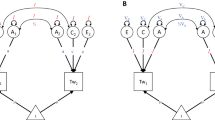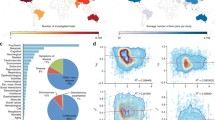Abstract
The classical twin design (CTD) uses observed covariances from monozygotic and dizygotic twin pairs to infer the relative magnitudes of genetic and environmental causes of phenotypic variation. Despite its wide use, it is well known that the CTD can produce biased estimates if its stringent assumptions are not met. By modeling observed covariances of twins’ relatives in addition to twins themselves, extended twin family designs (ETFDs) require less stringent assumptions, can estimate many more parameters of interest, and should produce less biased estimates than the CTD. However, ETFDs are more complicated to use and interpret, and by attempting to estimate a large number of parameters, the precision of parameter estimates may suffer. This paper is a formal investigation into a simple question: Is it worthwhile to use more complex models such as ETFDs in behavioral genetics? In particular, we compare the bias, precision, and accuracy of estimates from the CTD and three increasingly complex ETFDs. We find the CTD does a decent job of estimating broad sense heritability, but CTD estimates of shared environmental effects and the relative importance of additive versus non-additive genetic variance can be biased, sometimes wildly so. Increasingly complex ETFDs, on the other hand, are more accurate and less sensitive to assumptions than simpler models. We conclude that researchers interested in characterizing the environment or the makeup of genetic variation should use ETFDs when possible.














Similar content being viewed by others
Notes
We follow the convention that \( \hat{V}_{ \cdot } \) is the estimate of the population parameter \( V_{ \cdot } \)
Strictly speaking, \( C\hat{V}(A,F) \) is a nonlinear constraint and is not freely estimated in ETFDs. It is determined by, and helps to determine, estimated parameters by constraining their inter-relationships in a way that keeps the entire model internally consistent.
References
Carey G (2005) Cholesky problems. Behav Genet 35:653–665
Casela G, Berger RL (1990) Statistical inference. Wadsworth, Belmont
Cloninger CR, Rice J, Reich T (1979) Multifactorial inheritance with cultural transmission and assortative mating II: a general model of combined polygenic and cultural inheritance. Am J Hum Genet 31:176–198
Coventry WL, Keller MC (2005) Estimating the extent of parameter bias in the classical twin design: a comparison of parameter estimates from extended twin-family and classical twin designs. Twin Res Hum Genet 8:214–223
Crnokrak P, Roff DA (1995) Dominance variation: associations with selection and fitness. Heredity 75:530–540
Eaves LJ (1979) The use of twins in the analysis of assortative mating. Heredity 43:399–409
Eaves LJ (2009) Putting the ‘human’ back in genetics: modeling the extended kinship of twins. Twin Res Hum Genet 12:1–7
Eaves LJ, Last KA, Young PA, Martin NG (1978) Model-fitting approaches to the analysis of human behavior. Heredity 41:249–320
Eaves LJ, Eysenck HJ, Martin JM (eds) (1989) Genes, culture, and personality: an empirical approach. Academic Press, Londong
Fisher RA (1918) The correlation between relatives on the supposition of Mendelian inheritance. Trans Roy Soc Edinb 52:399–433
Fulker DW (1982) Extension of the classical twin method. In Bonné-Tamir B, Cohen T, Goodman RM (eds) Human genetics, part A: the unfolding genome (Progress in clinical and biological research 103A). Alan R Liss, New York, pp. 395–406
Grayson DA (1989) Twins reared together: minimizing shared environmental effects. Behav Genet 19:593–604
Haldane JBS (1932) The causes of evolution. Princeton University Press, Princeton, N.J.
Heath AC, Kendler KS, Eaves LJ, Markell D (1985) The resolution of cultural and biological inheritance: informativeness of different relationships. Behav Genet 15:439–465
Hill WG, Goddard ME, Visscher PM (2008) Data and theory point to mainly additive genetic variance for complex traits. PLos Genet 4:1–10
Keller, M. C. (2007). PedEvolve: a simulator of genetically informative data implemented in R. Annual meeting of the behavior genetics association, Amsterdam
Keller MC, Coventry WL (2005) Quantifying and addressing parameter indeterminacy in the classical twin design. Twin Res Hum Genet 8:201–213
Keller MC, Medland SE, Duncan LE, Hatemi PK, Neale MC, Maes HMM et al (2009) Modeling extended twin family data I: description of the cascade model. Twin Res Hum Genet 12:8–18
Maes HMM, Neale MC, Medland SE, Keller MC, Martin NG, Heath AC et al (2009) Flexible Mx specifications of various extended twin kinship designs. Twin Res Hum Genet 12:26–34
Martin NG, Boomsma DI, Machin G (1997) A twin-pronged attach on complex traits. Nat Genet 17:387–392
Medland SE, Keller MC (2009) Modeling extended twin family data II: power associated with different family structures. Twin Res Hum Genet 12:19–25
Miller G, Todd PM (1998) Mate choice turns cognitive. Trends Cogn Sci 2:190–198
Nance WE, Corey LA (1976) Genetic models for the analysis of data from the families of identical twins. Genetics 83:811–826
Neale MC (1999) MX: statistical modelling, 5th edn. Department of Psychiatry, Richmond, VA
Neale MC, Fulker DW (1984) A bivariate path analysis of fear data on twins and their parents. Acta Genetica Medica Gemellol (Roma) 33:273–286
Operario D, Tschann J, Flores E, Bridges M (2006) Brief report: associations of parental warmth, peer support, and gender with adolescent emotional distress. J Adolesc 29(2):299–305
Plomin R, DeFries JC, McClearn GE, McGuffin P (2001) Behavioral genetics, 4th edn. Worth Publishers, New York
Posthuma D, Boomsma DI (2000) A note on the statistical power in extended twin designs. Behav Genet 30:147–158
R Core Development Team (2009) R: a language and environment for statistical computing. R Foundation for Statistical Computing, Vienna, Austria
Reynolds CA, Baker LA, Pedersen NL (2000) Multivariate models of mixed assortment: phenotypic assortment and social homogamy for education and fluid ability. Behav Genet 30(6):455–476
Thiessen DD, Gregg B (1980) Human assortative mating and genetic equilibrium: an evolutionary perspective. Ethol Sociobiol 1:111–140
Truett KR, Eaves LJ, Walters EE, Heath AC, Hewitt JK, Meyer JM et al (1994) A model system for analysis of family resemblance in extended kinships of twins. Behav Genet 24:35–49
Wahlberg P (2009) Chicken genomics-linkage and QTL mapping. Digital comprehensive summaries of Uppsala. Dissertations from the Faculty of Medicine
Wright S (1929) Fisher’s theory of dominance. Am Nat 63:274–279
Author information
Authors and Affiliations
Corresponding author
Additional information
Edited by Gitta Lubke.
Rights and permissions
About this article
Cite this article
Keller, M.C., Medland, S.E. & Duncan, L.E. Are Extended Twin Family Designs Worth the Trouble? A Comparison of the Bias, Precision, and Accuracy of Parameters Estimated in Four Twin Family Models. Behav Genet 40, 377–393 (2010). https://doi.org/10.1007/s10519-009-9320-x
Received:
Accepted:
Published:
Issue Date:
DOI: https://doi.org/10.1007/s10519-009-9320-x




